In this project, we conducted the following training programs:
1. Training for the five government-approved rescue organizations (1623, 1624, 1625, 1628, 1630)*
*Foundation for assisting poor people of Lao PDR (1623), Vientiane Rescue (1624), Lao Red Cross Rescue Team (1625), China Foundation Rescue Emergency Call (1628), Houamchai Foundation (1630)
2. Training for emergency doctors and nurses at the three national central hospitals in the capital, Vientiane (Mittaphab Hospital, Setthathirath Hospital, Mahosot Hospital)
3. Training for the Medical Directors (who supervise the process from ambulance dispatch to hospital arrival) and Dispatchers (who receive emergency calls and issue dispatch orders to emergency teams) at the Command and Control Center, which was established with support from this project to receive 1195 calls (equivalent to 119 in Japan)
Most of the emergency teams operating in Laos are composed of ordinary citizens without professional qualifications. Since standard education on life-saving rescue is not provided within the organizations, there is a significant difference in the abilities of each emergency team member. As a result, the content and quality of pre-hospital care services provided at the accident scene or during transport to the hospital vary greatly depending on which emergency team is dispatched. In this project, we developed educational materials with Mittaphab Hospital to continuously train high-quality emergency teams and aimed to standardize education to minimize service variability and improve service quality.
| No. | Term | Duration | Participants | Activities |
| 1 | Aug 2022 | 5 days | 116 persons | Skill training |
| 2 | Dec 2022 | 7 days | 21 persons | Skill training
Simulation training Ambulance ride-along training |
| 3 | Aug 2023 | 4 days | 22 persons | Scenario training
Assisted delivery training Simulation training Task training |
| 4 | Feb 2024 | 2 days | – | Ambulance ride-along training
Comprehensive Exercise (Medical Rally) |
Experts conducted a one-day training session for each of the five rescue organizations. The training focused on basic skills. Some participants had slightly incorrect knowledge and skills, but through the training, they acquired the correct knowledge and skills.
The first half of the training period was a group training at Mittaphab Hospital, and the second half was training at each organization’s station. The participants were 21 individuals who played leadership roles in their respective organizations.
In the first half of the training, skill training and algorithm training were conducted. In the skill training, participants were trained in observation and treatment, including initial assessment, ESS input, and full-body observation for observation, and airway management and hemostasis for treatment. In the algorithm training, participants practiced continuous initial assessment, ESS input, and full-body observation. After the training, all participants were able to correctly input information into the ESS.
In the second half of the training, simulation training and ambulance ride-along training were conducted. The participants acted as instructors and trained themselve’s rescue members. By teaching others what they learned in the training, the participants deepened their understanding of observation and treatment. In the ambulance ride-along training, experts accompanied the rescue teams to actual accident scenes and supported them in applying what they learned in the training to real situations. Since there were no interpreters at the accident scenes, cards written in Lao were prepared in advance, and the experts used these cards to communicate with the rescue teams. At the actual accident scenes, ESS input was also performed, and the information entered into the ESS was checked on computers at the rescue stations.
The training included scenario training, childbirth assistance training, simulation training, and task training.
In the ambulance ride-along training, participants went to emergency scenes with the team members, checked the response situation at the scene, and provided feedback.
Additionally, they participated as evaluators in the comprehensive exercises conducted by Mittaphab Hospital. In the comprehensive exercises, rescue teams participated and responded to emergency scenarios such as traffic accidents and multiple casualties. The responses were evaluated and feedback was provided by Mittaphab Hospital staff and Japanese experts, and rankings were competed. The comprehensive exercises had been held once a year under the auspices of Mittaphab Hospital and provide a valuable opportunity for the teams to improve through competition.
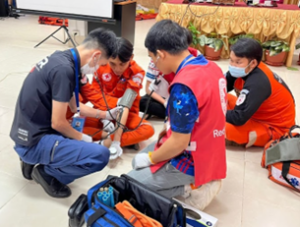
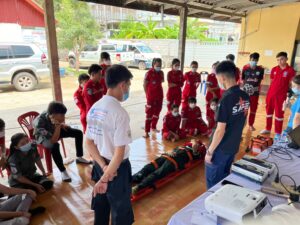
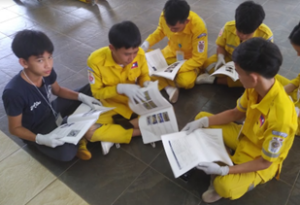
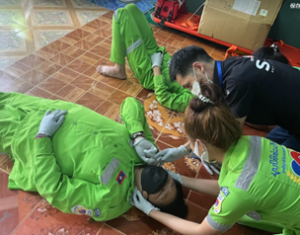
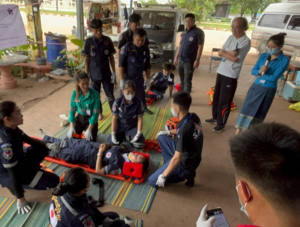
There are few doctors and nurses with the skills to treat severely injured patients, and the fields of emergency medicine and emergency nursing are not well established. In Laos, the first emergency physician was certified in 2020, but the number is still far from sufficient. Therefore, in collaboration with Khon Kaen University in Thailand, which is a partner school of the University of Tsukuba, we developed a human resource training program through trilateral cooperation between Japan, Laos, and Thailand. The aim was to improve the skills of Lao doctors and nurses in accepting and resuscitating severely injured traffic accident patients.
| No. | Term | Training Theme |
| 1 | Feb 2022 | Thailand EMS in COVID-19 |
| 2 | May 2022 | Cardiac Arrest & Severe Trauma |
| 3 | Aug 2022 | EMS System |
| 4 | Nov 2022 | Stroke FAST Track |
In 2022, when travel and other activities were restricted due to the COVID-19 pandemic, remote training sessions were held every three months with lecturers from Khon Kaen University.
The training themes were determined based on needs assessments conducted on the Lao side, and each lecture featured active discussions.
To maximize the effectiveness of the training, YouTube and Google Drive were used to ensure that those who could not participate on the day could watch the recorded lectures online at any time.
| Sending Hospitals |
Training Period | No. of Trainers | ||
| Doctors | Nurses | Total | ||
| Mittaphab Hospital | 2weeks | 2 | 9 | 11 |
| Mahosot Hospital | 2weeks | 3 | 7 | 10 |
| Setthathirath Hospital | 2weeks | 3 | 7 | 10 |
| University of Health Sciences Laos | 4weeks | 8 | – | 8 |
| Total | 16 | 23 | 39 | |
In 2023, when on-site training in Thailand became possible, we dispatched a total of 39 emergency physicians, emergency nurses from three central hospitals, and resident doctors from the University of Health Sciences Laos to Khon Kaen University from January to July. The training period was divided into three segments. Graduates of each segment conducted remote case presentations with Khon Kaen University and the three central hospitals in February and May 2023, and in August, Khon Kaen University was invited to Laos for in-person case presentations. Many specific suggestions were heard on how to apply the knowledge gained in Thailand to Laos, making the training highly fruitful.
Third-country training for doctors and nurses from the three national central hospitals and the University of Health Sciences in Khon Kaen University.
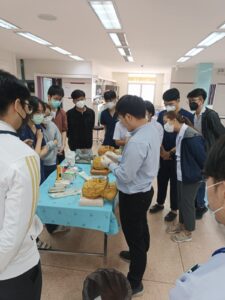
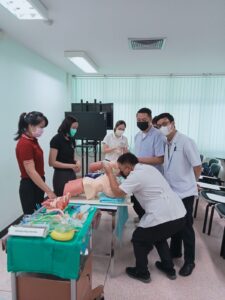
In this project, we supported the establishment of the Command and Control Centre (CCC). Consequently, the CCC was staffed with Medical Directors who oversee the process from the dispatch of emergency teams to their arrival at the hospital, and Dispatchers who receive emergency calls and issue dispatch orders to the emergency teams.
A total of eight MD were selected: four from Mittaphab Hospital, two from Setthathirath Hospital, and two from Mahosot Hospital.
The training was conducted by Khon Kaen Regional Hospital, our cooperating institution, through remote training and on-site training (third-country training) at Khon Kaen Regional Hospital. Khon Kaen Regional Hospital was a counterpart institution in a JICA technical cooperation project aimed at reducing traffic trauma deaths in Thailand in the early 2000s. Currently, Khon Kaen Regional Hospital leads emergency medical care in Thailand and guides neighboring countries, promoting leadership in this field in the Mekong region. This training exemplifies the triangular cooperation, a feature of this grassroots technical cooperation.
From March to May 2022, lectures and workshops (each lasting five days) were held.
The lectures aimed to acquire basic knowledge using the emergency medical service system in Khon Kaen, Thailand, as an example.
In the workshops, participants worked on the operation of the CCC in Laos, methods for dispatching ambulances, and creating rules for selecting hospitals for patient transport, based on the knowledge gained in the previous training.
In August 2022, eight instructors were dispatched to Khon Kaen Regional Hospital for a five-day training session.
At the start of the development, experts developed training materials with Mittaphab Hospital. This ensured that standard education could continue even after the project’s completion.
The training was mainly conducted at the CCC. In addition to training by experts, system usage training by SAFER local staff was also conducted as needed, given that the rescue team members dispatched as dispatchers varied daily.
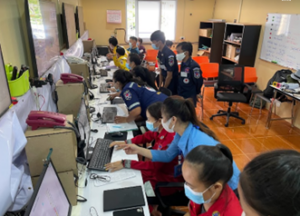
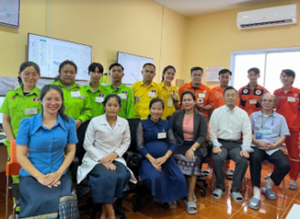
The articles, photographs, illustrations, etc. on this website are protected by copyright law.
Therefore, reprinting, copying, reproduction, translation, etc. without permission of the copyright holder is prohibited by law.
If you wish to reprint, etc., please contact us at the e-mail address below.